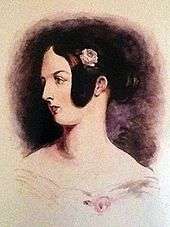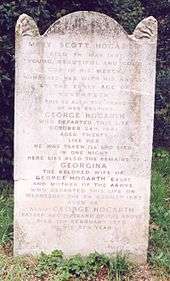Mary Hogarth
| Mary Hogarth | |
|---|---|
 Portrait of Hogarth aged 16 | |
| Born |
Mary Scott Thompson Hogarth 1819/20 Edinburgh, Scotland |
| Died |
7 May 1837 (aged 17) London, England |
| Known for | Sister-in-law of Charles Dickens |
| Relatives |
Catherine Dickens (sister) Georgina Hogarth (sister) George Hogarth (father) |

Mary Scott Thompson Hogarth (1819/20[lower-alpha 1] – 7 May 1837[lower-alpha 2]) was the sister-in-law of Charles Dickens and the sister of Catherine Dickens (née Hogarth). Hogarth lived with the Dickens family for one of the 17 years of her life, and was the inspiration for a number of characters in Dickens novels.
Life
Hogarth was the daughter of George Hogarth (1783–1870) and Georgina Hogarth née Thompson (1793–1863). She was born in Edinburgh, where her father was a legal advisor to Walter Scott, whom the young Dickens greatly admired.[1] She was one of ten children, and was the third child, and second daughter.[2][3] Hogarth was named after her grandmother.[4]:73 Her father George was also a music critic, cellist and composer, who worked for the Edinburgh Courant magazine. In 1830, he founded the Halifax Guardian, in 1834 he became a music critic for The Morning Chronicle newspaper in London, and in 1835 he became editor-in-chief of The Evening Chronicle, a post he held for twenty years.[5] Mary first met Charles Dickens with her sister Catherine when she was aged 14.[6][7] After Charles and Catherine Dickens married in 1836, Hogarth lived with them for a month at the Furnival's Inn in Holborn, and from March 1837, Hogarth lived with them at 48 Doughty Street.[8]:194[9][10][6]
Death
Hogarth died suddenly at the Dickens family home aged 17 on 7 May 1837. The cause of death is believed to have been either heart failure or a stroke.[11] She was buried on 13 May at the Kensal Green Cemetery, London.[8]:91[11] Dickens wrote the epitaph on her tombstone, which says "Young, beautiful, and good, God numbered her among his angels at the early age of seventeen".[2] The tombstone now includes epitaphs to her brother George, and their parents Georgina, who died in 1863, and George, who died in 1870.[4]:344 The bedroom where Hogarth died is now part of the Charles Dickens Museum.[11] As a result of Hogarth's death, Charles Dickens missed the publication dates for The Pickwick Papers and Oliver Twist. It was the only time in his life that Dickens missed publication dates. As a reason for missing the publication dates, he wrote that "he had lost a very dear young relative to whom he was most affectionately attached, and whose society has been, for a long time, the chief solace of his labours". He wore Hogarth's ring for the rest of his life.[11][2]
Inspiration for Dickens characters
Mary is believed to have been the inspiration for a number of Dickens characters. She is seen as the inspiration for Rose Maylie in Oliver Twist,[10] which was publishing serially when Mary died, (although Rose suffered a similar illness like Mary, she does not die in the novel). Little Nell in The Old Curiosity Shop inherited beauty and gentleness, innocence and purity, traits that Dickens had associated with Mary, and Nell dies suddenly in the book. Other characters believed to have been inspired by Mary include Kate Nickleby, the 17-year-old sister of the hero of the novel Nicholas Nickleby; Agnes Wickfield, the heroine in David Copperfield (her character was a mixture of both Mary and Georgina, Dickens' another sister-in-law) and Ruth Pinch from Martin Chuzzlewit.[10][7][9][11]
Notes
References
- ↑ Ackroyd, Peter (2002). Dickens: Public Life and Private Passions. BBC. p. 17. ISBN 0563534737.
- 1 2 3 "Charles Dickens: Family and Friends". David Perdue's Charles Dickens Page. Retrieved 25 February 2017.
- ↑ Page, Norman (September 1984). A Dickens Companion. Springer Publishing. Retrieved 25 February 2017.
- 1 2 Page, Norman (December 1999). Charles Dickens: Family History. Psychology Press. ISBN 978-0415222334. Retrieved 25 February 2017.
- ↑ Smiley, Jane (2002). Charles Dickens. Viking Adult. ISBN 0-670-03077-5.
- 1 2 Slater, Michael (1983). Dickens and Women. London: J. M. Dent & Sons. pp. 78–79. ISBN 0-460-04248-3.
- 1 2 Schlicke, Paul (1999). Oxford Reader’s Companion to Dickens. Oxford: Oxford University Press. ISBN 0-19-866253-X.
- 1 2 Nayder, Lillian (April 2012). The Other Dickens: a life of Catherine Hogarth. Cornell University Press. Retrieved 25 February 2017.
- 1 2 Allingham, Phillip V. "Mary Scott Hogarth, 1820–1837: Dickens's Beloved Sister-in-Law and Inspiration". Victorian Web. Retrieved 25 February 2017.
- 1 2 3 Davis, Paul (1999). Charles Dickens from A to Z. New York: Checkmark Books. ISBN 0-8160-4087-7.
- 1 2 3 4 5 Gottlieb, Robert (June 2010). "Who Was Charles Dickens?". The New York Review of Books. Retrieved 25 February 2017.
Further reading
- John Forster, The Life of Charles Dickens, London, Cecil Palmer, 1872–1874
- Mamie Dickens, Georgina Hogarth, The Letters of Charles Dickens from 1833 to 1870, LLC, Kessinger Publishing, 1882 ( ISBN 1161415963 and 978-1161415964)
- George Dolby, Charles Dickens as I Knew Him, New York, C. Scribner's sons, 1912
- (fr) André Maurois, La Revue de Paris, n° 6, année 41, 15 novembre 1934, « Portraits nouveaux de Charles Dickens », Bibliothèque nationale de France, Gallica
- Sir Felix Aylmer, Dickens Incognito, London, Hart-Davis, 1959
- Albert J. Guerard, The Triumph of the Novel: Dickens, Dostoevsky, Faulkner, New York, Oxford University Press, 1976 ( ISBN 0195020669 et 9780195020663), chapitre 3
- Fred Kaplan, Dickens: A Biography, New York, William Morrow, 1988
- Peter Ackroyd, Dickens, New York, Harper Perennials, 1992, 1195 p. ( ISBN 0060922656 et 9780060922658)
- Charles Dickens, The Letters of Charles Dickens, éd. Madeline House, Graham Storey et al., Oxford, Clarendon Press, 1965–2002
- David Paroissien (dir.), A Companion to Charles Dickens, Chichester, Wiley Blackwell, 2011 ( ISBN 978-0-470-65794-2)